If you’ve ever tried to work with your manager peering over your shoulder, you’re probably aware of the adverse effects of working under a micromanaging leader.
You may have even dreamed of the day you’ll get to work under a manager with a more hands-off approach to leadership.
But, the grass isn’t always greener on the other side of the fence.
Though the laissez-faire leadership style is perfect for some work environments, it also comes with its own set of challenges.
Going forward, we’ll discuss:
- What laissez-faire leadership is,
- The main characteristics of this leadership style,
- Real and fictional examples of laissez-faire leaders,
- The pros and cons of laissez-faire leadership, and
- What you can do to become a better laissez-faire leader.
Along the way, we’ll also talk about the optimal conditions for laissez-faire leadership as well as how this style of leadership compares to democratic leadership.
So, without further ado, let’s get started.

Table of Contents
What is laissez-faire leadership?
According to Cynthia Mathieu’s 2021 book Dark Personalities in the Workplace, laissez-faire leadership is exemplified by the conspicuous absence of leadership and the leader’s reluctance to intervene.
After all, the French term “laissez-faire” literally translates to “let do” — i.e. “let the people do as they choose.” Alternatively, for a more natural translation, we can go for: “let it be.”
In any case, that means that leaders who take this approach tend to be pretty hands-off when it comes to managing their teams. Instead of offering support or encouragement, they may:
- Avoid giving feedback and
- Delay making decisions.
In her book, Mathieu notes that laissez-faire leadership is one of the 3 styles of leadership that make up the Full-Range Leadership Model. Proposed by researchers Bernard M. Bass and Bruce J. Avolio, the model consists of:
- Transactional leadership,
- Transformational leadership, and
- Laissez-faire leadership.
However, of those 3 approaches to leadership, laissez-faire is the only one that is based on a policy of complete non-interference.
Having said that, let’s talk about the main characteristics of the laissez-faire leadership style.
Characteristics of laissez-faire leadership
If we looked at the laissez-faire leadership style in an unflattering light, we might say that this kind of leadership is marked by avoidance. In that sense, a poor laissez-faire leader might avoid:
- Taking a stand on issues or giving feedback,
- Developing or rewarding followers,
- Making decisions, and
- Taking responsibility.
However, in recent years, the concept of laissez-faire leadership has evolved to become a positive alternative to micromanagement.
Even though laissez-faire leaders still offer minimal intervention or guidance and encourage employees to make decisions and solve their own problems independently, they also:
- Provide plenty of resources and tools for employees to do their jobs,
- Offer constructive criticism and feedback on occasion,
- Take charge as necessary, and
- Take responsibility for the overall actions of their employees.
According to Paul Bramson, a Professional Training Expert and Keynote Speaker we spoke to, laissez-faire leadership as it exists now is characterized by:
- Limited feedback and guidance,
- Creative and innovative culture,
- Autonomous decision-making,
- Flexible work environment,
- Minimal intervention, and
- High trust.
Share constructive feedback on Pumble
Essentially, leaders have had to incorporate traits that are typically associated with other leadership styles to make laissez-faire leadership more effective.
Though this style of leadership remains delegative at its core, taking a more modern approach should help you avoid the pitfalls some researchers associate with laissez-faire leadership.
But, we’ll talk more about those disadvantages of laissez-faire leadership later on. For now, let’s see what this style of leadership looks like in practice.

Real and fictional examples of laissez-faire leadership
Now that we know some basic characteristics of the laissez-faire style of leadership, we can see why some people may not be too eager to claim the title of “laissez-faire leader.”
Being called a transformational leader would probably be more flattering, right?
But, what if we told you you could be both in different contexts — like Steve Jobs was?
From Queen Victoria to John F. Kennedy, and even leaders outside of the political sphere, most of the people who have been associated with this style of management have had to adjust their approach depending on the situation.
Having thus discovered that the laissez-faire leadership style isn’t one that can ever be applied in its purest form, we set out to find a laissez-faire leader who really “walks the walk,” as they say.
That led us to explore more exaggerated laissez-faire leadership examples from movies and TV shows, which include:
- Dr. Gregory House from House,
- John Hammond from Jurassic Park,
- Chief Wiggum from The Simpsons,
- Sansa Stark from Game of Thrones (in season 7), and
- Ron Swanson from Parks and Recreation.
In the end, the leaders we have chosen to use as the perfect examples of laissez-faire leadership are:
- Warren Buffet,
- Paul Allen, and
- Ron Swanson.
So, let’s see how each of these people employed this style of management.
Example #1: Warren Buffett, CEO of Berkshire Hathaway
The only way you get to be as successful as Warren Buffett has become is by knowing how to delegate — which is a key skill associated with the laissez-faire leadership style.
Over the course of his decades-long career, Buffett’s conglomerate holding company, Berkshire Hathaway Inc., has acquired numerous subsidiaries, though its primary source of income is insurance.
Outside of its permanent holdings, the company also partially owns Pilot Flying J, food and drink businesses like the Kraft Heinz Company and the Coca-Cola Company, banking businesses like American Express and the Bank of America, and even the tech giant, Apple.
As the person who oversaw many of these acquisitions, Warren Buffett has had to reduce his involvement in the running of these individual ventures, thus earning himself a spot on this list.
Surrounding himself with capable and intelligent people has been the key to Buffett’s successful tenure as CEO and chairman of Berkshire Hathaway.
His laissez-faire approach to leadership is, perhaps, best seen in the following quote, which was attributed to him in one of Berkshire Hathaway’s annual reports:
“We tend to let our many subsidiaries operate on their own, without our supervising and monitoring them to any degree. Most managers use the independence we grant them magnificently, by maintaining an owner-oriented attitude.”
Example #2: Paul Allen, Co-Founder of Microsoft
As we have established, different situations often require different approaches to leadership. The same person who is seen as a servant leader in one context, can be seen as more of a hands-off manager in another.
That’s exactly how the Co-Founder of Microsoft, Paul Allen, landed on our list.
Though Allen was famous for his enthusiastic and visionary leadership in the decades following his stint at Microsoft, he was primarily seen as a laissez-faire leader during his time at Microsoft.
Namely, Allen was notably less involved in the running of the business than his co-founder, Bill Gates.
According to Allen, there was no need for him to get involved, while Gates “drove others as hard as he drove himself.”
And so, Allen took on a more hands-off approach since letting Gates lead seemed easier:
“It was tough not to back off against Bill, with his intellect and foot tapping and body rocking; he came on like a force of nature.”
Gates’ energetic approach to leadership caused Allen to retreat and become even more reluctant to take on those leadership tasks. That ultimately made it easier for Gates to renegotiate the ownership of Microsoft to a 64:36 split in his favor.
Eventually, illness caused Allen to take a step back from Microsoft and focus on other investments and philanthropic activities. One of his areas of interest is sports team ownership, which we can use to further demonstrate his laissez-faire approach to leadership.
In his memoir, Idea Man, Allen explained that he gladly defers to the opinions of the experts he employs, writing:
“While I sign off on trades or free agents, I’ve rarely overruled my basketball people’s decisions. But I’m not shy about steering the discussion or pushing deeper if something doesn’t make sense to me.”
Example #3: Ron Swanson from Parks and Recreation
Ultimately, real people never really fit neatly into one leadership style. They are all too aware that different individuals, teams, and organizations require different leadership approaches.
But, that’s not the case for fictional characters — particularly sitcom characters, who tend to fall into behavioral tropes that correspond to specific leadership styles.
With that in mind, we wanted to spotlight a character that perfectly represents the laissez-faire leadership style — Ron Swanson from Parks and Recreation.
For most of the show’s runtime, Ron held the position of the Director of the Pawnee City Department of Parks and Recreation.
As such, he had to interact with various unique personalities working under him as well as the occasional community member who came to the office.
Even so, Ron’s commitment to the laissez-faire lifestyle was evident in his disinterested response to most of his subordinates’ daily tasks.
As far as he was concerned, they could do their jobs in whichever way they preferred, as long as it didn’t result in negative consequences he’d have to deal with.
Swanson’s exaggerated approach to laissez-faire leadership is best summed up by the following line from the show:
“If any of you need anything at all… Too bad. Deal with your problems yourselves like adults.”
Laissez-faire leadership pros
As we have previously noted, laissez-faire leadership can be both beneficial and detrimental to your team and company, depending on the situation.
As Paul Bramson told us, there are times when this style of leadership is warranted:

“Although the phrase itself seems to have a negative connotation and perception, when the circumstances and the team are right, this style of leadership is the absolute right way to go. The success of this leadership style depends on the team’s maturity, competence, motivation, and willingness to take responsibility for their actions.”
So, let’s talk about the laissez-faire leadership benefits you might experience if all those stars align.
Pro #1: Laissez-faire leadership lets leaders prioritize
One of the primary benefits of the laissez-faire leadership style is that it allows the leader to prioritize segments of their work that aren’t related to their subordinates.
In other words, you can focus on steering the ship and trust that your team will handle the specifics.
That’s why trust is a core building principle of this approach, according to Paul Bramson:

“My time is best spent innovating and driving the business. Surrounding myself with high performers allows me to lead in this way, knowing that everything else is taken care of. My team is accustomed to hearing me say, ‘Great, just run with it,’ as if they think they have it. I know they do and don’t need me muddying things up.
Additionally, having this level of a team, when we create new programs or content, I can tap into the variety of talent and expertise around me to ensure what we train on or put out in the world is the best it can be. What a luxury… as a leader.”
💡 PUMBLE PRO TIP
Establishing trust in your team is the first step to relinquishing control and practicing laissez-faire leadership. To learn more about building trust — particularly in remote work settings — check out the following blog post:
Pro #2: Laissez-faire leadership encourages accountability
The second benefit of laissez-faire leadership is that it encourages accountability on all levels.
On the one hand, letting your employees do their jobs however they see fit will make them feel more accountable for their actions — whether they have positive or negative results.
If your employees feel accountable for their professional failures, they’ll also feel a greater ownership of their successes.
According to a Business Leadership Coach, Diane Rosen, granting employees autonomy will naturally encourage ownership:

“Employees need autonomy to have a sense of ownership of their work product. With ‘skin in the game,’ they know they are responsible for their work. Research has shown that when employees have autonomy, they are more likely to be energized, engaged, and perform better.”
Then again, the healthy kind of laissez-faire leadership requires the leader to practice accountability, too.
If you’ve allowed your team to do their jobs however they see fit without offering further instructions, you have to accept any negative consequences that come your way.
In other words, a laissez-faire leader must take responsibility for their team in front of higher-ups and external parties alike.
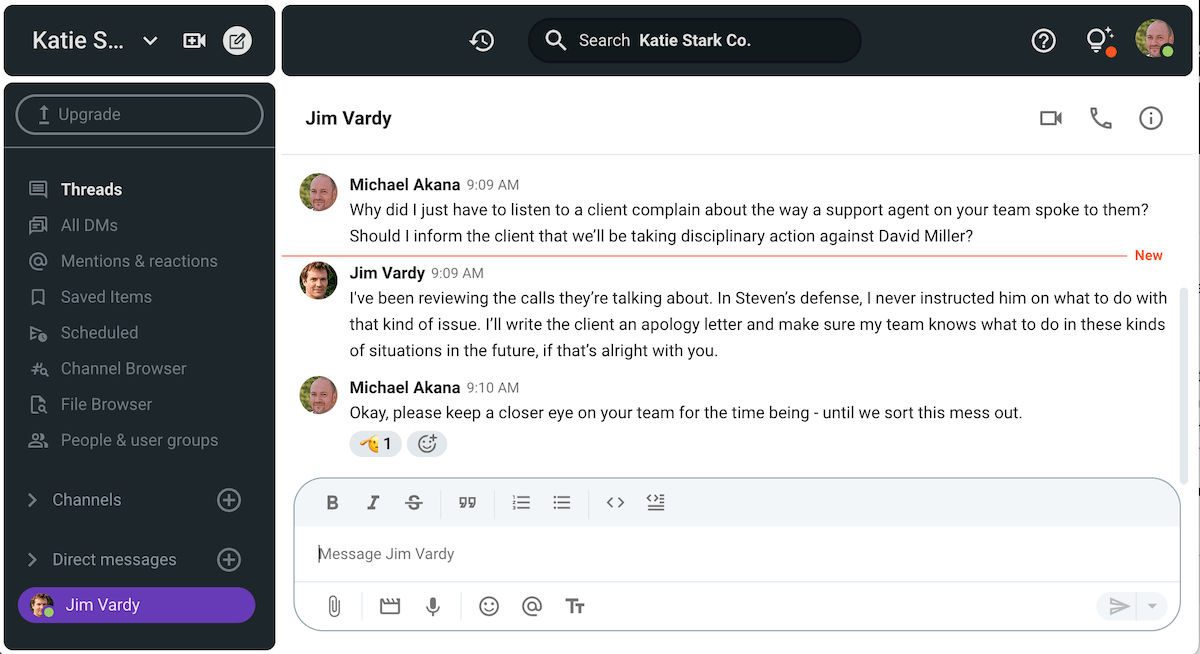
💡 PUMBLE PRO TIP
The above screenshot shows an exchange between a laissez-faire team leader and their manager. To learn more about upward and downward communication, check out these blog posts:
Practice your leadership and communication skills in Pumble, the team communication app
Pro #3: Laissez-faire leadership gives employees creative freedom
In addition to having a greater sense of accountability and ownership over their work, employees working under a laissez-faire leader also have more creative freedom.
After all, a laissez-faire leader only cares about the job being done — they don’t lose sleep over how it was accomplished.
According to Paul Bramson, that allows employees to think outside the box:

“By granting autonomy and freedom to team members, the laissez-faire style fosters creativity and encourages innovative thinking. Team members are more likely to come up with unique solutions and ideas when they have the space to explore and experiment.”
To make sure everyone on their team has the space to experiment creatively, a laissez-faire leader first needs to learn about their employees’ strengths and weaknesses, skills, and talents.
That’s how they’re able to assign each team member tasks they will naturally excel at and feel comfortable being creative with.
Pro #4: Laissez-faire leadership prompts professional development
Generally, laissez-faire leaders use their knowledge of their employees’ skills to play to their strengths without actively trying to develop their weaknesses. That lack of development can easily be seen as a disadvantage of this approach to management.
To put it plainly, a laissez-faire leader isn’t likely to organize any skill-building workshops.
However, in letting their employees handle any challenges that come their way without interference, laissez-faire leaders are also encouraging their professional growth.
According to Paul Bramson, becoming more self-reliant will allow employees to develop many crucial skills:

“Allowing team members to make decisions and handle tasks independently promotes skill development, ongoing learning, and growth. They learn to take initiative, solve problems, and become more self-reliant, which can lead to a more capable and efficient team in the long run.”
Furthermore, this development of self-motivation and decision-making skills will also create future leaders out of these employees.
Pro #5: Laissez-faire leadership creates a relaxed work environment
For those of us who have had the misfortune of working under a helicopter boss, there’s nothing that can sour a workplace atmosphere faster than the arrival of one’s (micro)manager.
In fact, the absence of a tyrannical boss is one of the hallmarks of a positive work environment.
That kind of stress usually doesn’t exist on teams that are managed by a laissez-faire leader.
Rather, the flexibility a laissez-faire leader offers creates a low-pressure work environment most people will thrive in.
According to Dr. David Lenihan, President and CEO of Ponce Health Sciences University with academic experience in neuroscience, healthcare law, and business administration, workplace stability is one of the main benefits of laissez-faire leadership:

“Laissez-faire leadership (LFL) is driven by possessing a relaxed, confident, and easygoing demeanor. You don’t get too worked up over the bad stuff, and you also don’t get too excited over the good stuff. Your aim is to project a steady energy that will maintain stability and peace in the workplace.”
💡 PUMBLE PRO TIP
Creating a stable work environment is the best way to provide psychological safety to your employees. To learn about the exact steps you can take to create that kind of atmosphere in your workplace, check out this blog post:
Pro #6: Laissez-faire leadership increases employee retention
Lastly, let’s discuss the culmination of all the laissez-faire leadership benefits we have listed so far.
As Paul Bramson noted, working in a relaxed environment with full control over your work is sure to increase employees’ levels of job satisfaction:

“Laissez-faire leadership empowers team members by giving them ownership and control over their work. This can lead to higher job satisfaction, increased motivation, and a stronger sense of responsibility.”
After all, people who know what they’re doing can quickly become resentful and disillusioned by working under a micromanager.
Conversely, working under a hands-off leader will let these people do what they do best without interference, which will make them want to stick around.
Then again, not everyone thrives under laissez-faire management.
With that in mind, let’s discuss the various disadvantages of this leadership style.
Laissez-faire leadership cons
In her book, Dark Personalities in the Workplace, Cynthia Mathieu notes that, of the 3 leadership styles that make up the Full-Range Leadership Model, laissez-faire leadership has the greatest potential for negative impact:
“The absence of real leadership means that employees are not receiving the benefits of having a great leader; they are not getting the support they need and the recognition for the work they do. More importantly, an absent leader cannot transmit organizational values and, therefore, leaves the door open for ill-intentioned individuals to take advantage of the team’s resources, human and material.”
The award-winning Business Strategist and Leadership Coach, Jerome Myers, told us even more reasons why someone might wish to avoid this style of leadership:

“Weaknesses of laissez-faire leadership include the:
- Absence of oversight,
- Limited control over quality,
- Risk of inconsistent performance,
- Reduced productivity in team members who lack self-motivation, and
- Conflict from different interpretations of roles and responsibilities.”
So, in effect, a team’s work satisfaction and productivity could deteriorate under laissez-faire leadership just as easily as they might improve.
Having said that, let’s see what the experts we have spoken to have to say on the downsides of laissez-faire leadership.
Con #1: Laissez-faire leaders don’t provide direction
Several of the experts we have spoken to noted the lack of direction laissez-faire leaders provide as a significant drawback of this leadership style.
According to Paul Bramson, employees who require directions simply won’t get them from a laissez-faire leader:

“One of the significant drawbacks of laissez-faire leadership is the absence of clear direction and guidance. Without proper oversight, team members may lose focus or struggle to align their efforts with organizational goals.”
This is particularly problematic when it comes to handling new hires or transfers, as Jerome Myers notes:

“Laissez-faire leadership is not a suitable style for novice or newly formed teams when the results have to be predictable and the quality is one of the most important factors related to success.”
Ultimately, this drawback can be circumvented by understanding the needs of your employees, as Diane Rosen suggests:

“The degree of autonomy should match the skill set of the employee while also providing some room to grow. The key is to find the appropriate level of supervision — not micromanaging or letting someone go unprepared for the work, but making sure the employee can do the job.”
Con #2: Laissez-faire leadership can lead to a lack of accountability
Interestingly, taking a laissez-faire approach to leadership can just as easily lead to a lack of accountability as it can to increased accountability among employees.
Paul Bramson warns that employees could claim that their mistakes were the result of inadequate instructions:

“When leaders are hands-off, it can lead to accountability problems. Team members may not feel responsible for their actions, and the lack of oversight might result in a lack of commitment to meeting deadlines and delivering quality work.”
And, vice versa, managers can redirect blame to their employees even if a mistake happened due to their lack of oversight.
All this can lead employees to distrust or disrespect the leader, according to Paul Bramson.
Because of that, Constance Dierickx, a Business Psychologist, Decision Scientist, and Executive Leadership Coach we reached out to, recommends avoiding this style of leadership in high-responsibility jobs:

“Avoid [taking a laissez-faire approach to leadership] when risks are high and consequences of mistakes are significant.”
Con #3: Laissez-faire leadership can compromise communication
One of the worst potential consequences of this leadership style is that it can drastically decrease the quality of communication in the workplace.
A hands-off leader can be a significant organizational barrier to communication.
Simply put, not being able to contact the leader can make it difficult for everyone on the team to do their jobs.
It can even make communication between team members more difficult, according to Paul Bramson:

“Laissez-faire leadership can sometimes lead to poor communication between team members. The lack of structured communication channels may cause important information to be missed, leading to misunderstandings and inefficiencies.”
In other words, executive communication isn’t the only type of communication that might suffer in a workplace helmed by an absentee leader.
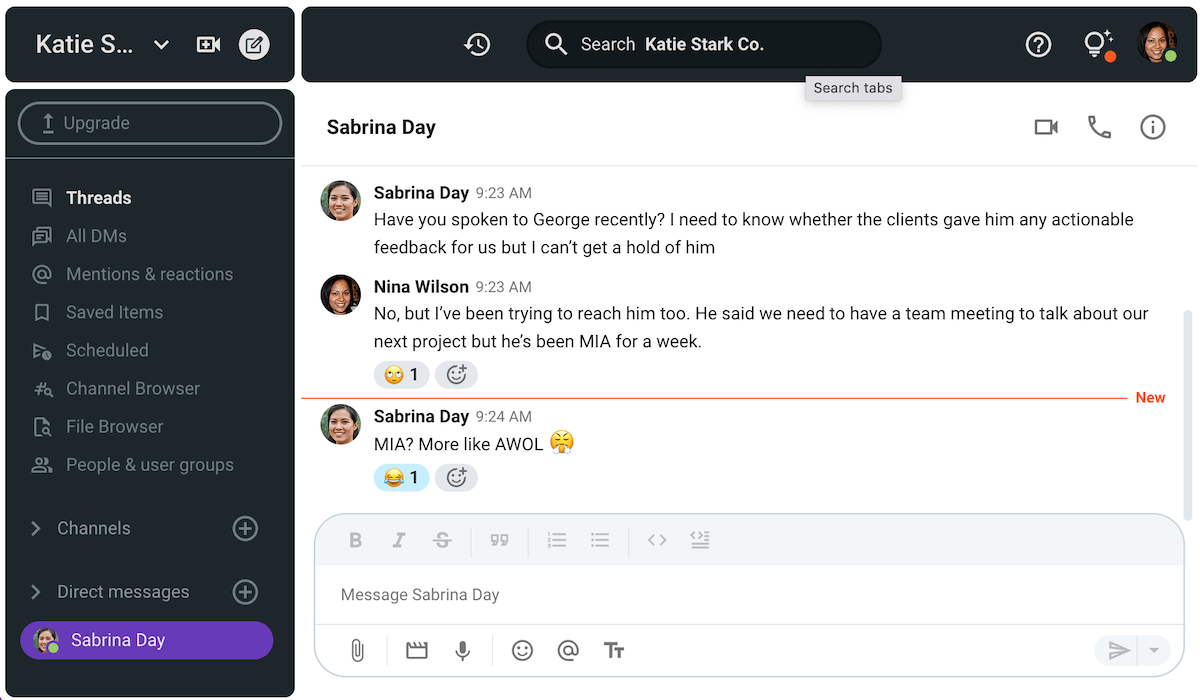
Communication gaps may occur between team members in all sorts of communication situations, especially when large groups of people are working under a laissez-faire leader.
💡 PUMBLE PRO TIP
Poor communication can lead to professional failures, financial consequences, and employee burnout. If you want to see the statistics behind these claims, check out the following blog post:
Overcome communication barriers and boost team connection with Pumble
Con #4: Laissez-faire leaders don’t provide support
Most people consider the transformation of people from mere employees to productive followers to be the goal of leadership.
But, for that transformation to happen, a leader must invest significant resources into each of their employees.
That is not something the stereotypical laissez-faire leader is willing to provide, which means that this style of leadership is marked by a conspicuous lack of support.
Even though that lack of support is somewhat acceptable when managing skilled employees, Paul Bramson says that not all employees will appreciate that approach:

“While this leadership style can be beneficial for highly motivated and skilled team members, it may not be suitable for everyone. Some employees might require more guidance and support to perform at their best, leading to uneven performance within the team.”
So, laissez-faire leadership in its purest form doesn’t offer much in the way of support.
Yet, according to Diane Rosen, a skilled leader should be able to provide both autonomy and support:

“Autonomy must be counterbalanced with support. The idea is not to put the employee in a sink or swim situation which can set them up for failure, but rather to make sure that they have the knowledge, skills, and resources to do their work and are encouraged to seek assistance when needed.”
Learning how to support your employees when it counts can go a long way toward making laissez-faire leadership a viable option in a greater set of circumstances.
Con #5: Laissez-faire leadership can lead to hierarchical confusion
As you can imagine, the stereotypical laissez-faire leader has minimal contact with their subordinates.
In the worst-case scenario, that can lead to hierarchical confusion as employees struggle to understand who their leader is, in the first place.
Basically, people may not know who they should turn to when they need guidance because their leader usually offers no guidance unprompted.
This can be particularly evident in times of crisis when teams require a more directive approach, according to Paul Bramson:

“When there is a lack of clear goals, direction, and vision, a laissez-faire approach can lead to confusion and misalignment among team members. In these situations, a more directive leadership style might be necessary to provide clarity and focus.”
Bramson also added that leadership confusion can lead to inefficient decision-making:

“In situations where prompt decision-making is crucial, the laissez-faire style might hinder progress. Without clear leadership and decision-making processes, critical choices may be delayed or overlooked, impacting the team’s performance.”
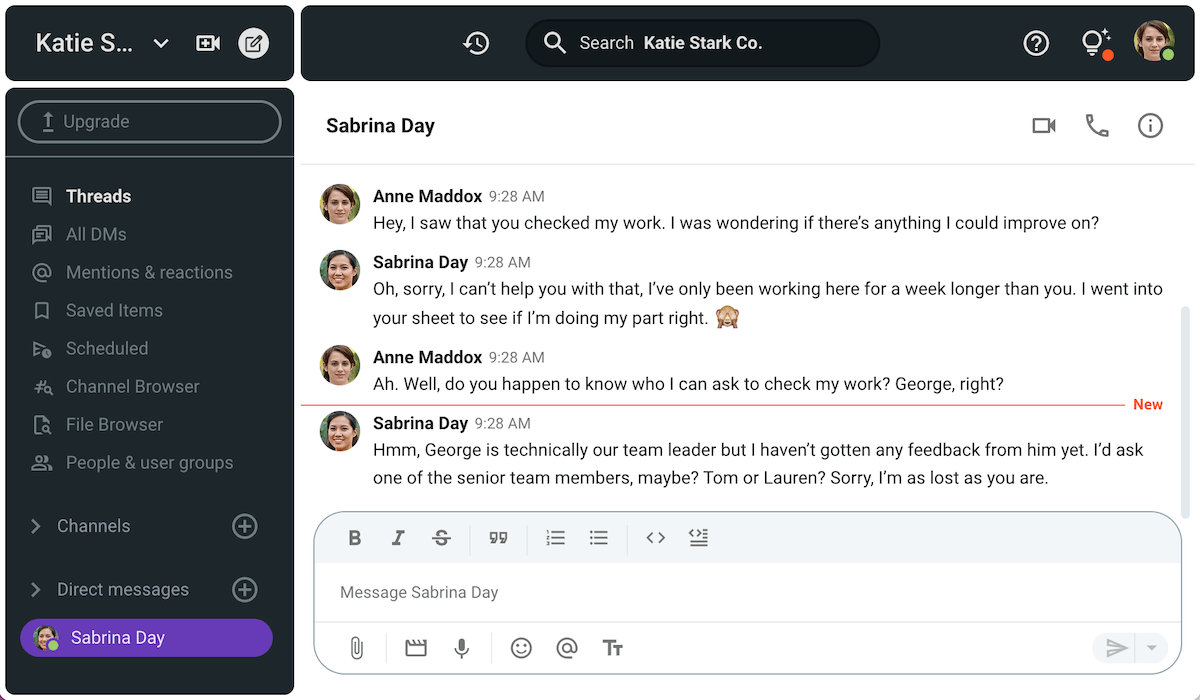
Con #6: Laissez-faire leaders can seem uninterested and detached
Due to the detached nature of the laissez-faire leadership style, the final drawback we’ve highlighted should come as no surprise.
Namely, some laissez-faire leaders can come across as uninterested in the workings of their team or even company.
In Paul Bramson’s opinion, that can make this style of leadership devolve into plain absenteeism:

“In extreme cases, laissez-faire leadership can devolve into absentee leadership, where the leader is entirely disengaged from the team. This can result in:
- A lack of direction,
- Organizational instability, and
- Decreased team morale.”
In other words, the line between laissez-faire leadership and absentee leadership is pretty blurry.
In fact, in Cynthia Mathieu’s book, Dark Personalities in the Workplace, laissez-faire leaders are described as being “absent when employees need them.”
But, the disinterest some laissez-faire leaders showcase may go even further than that.
In her book, Mathieu mentioned one of her previous works, in which she tried to connect psychopathy to the 3 leadership styles that make up the Full-Range Leadership Style.
The result of her research showed that psychopathic leaders were more inclined to showcase laissez-faire leadership traits than the traits that are associated with transformational or even transactional leadership.
So, that’s the most concerning drawback of this leadership style — not knowing whether it was consciously chosen due to the high level of expertise of one’s employees or due to the leader’s negligence and indifference.
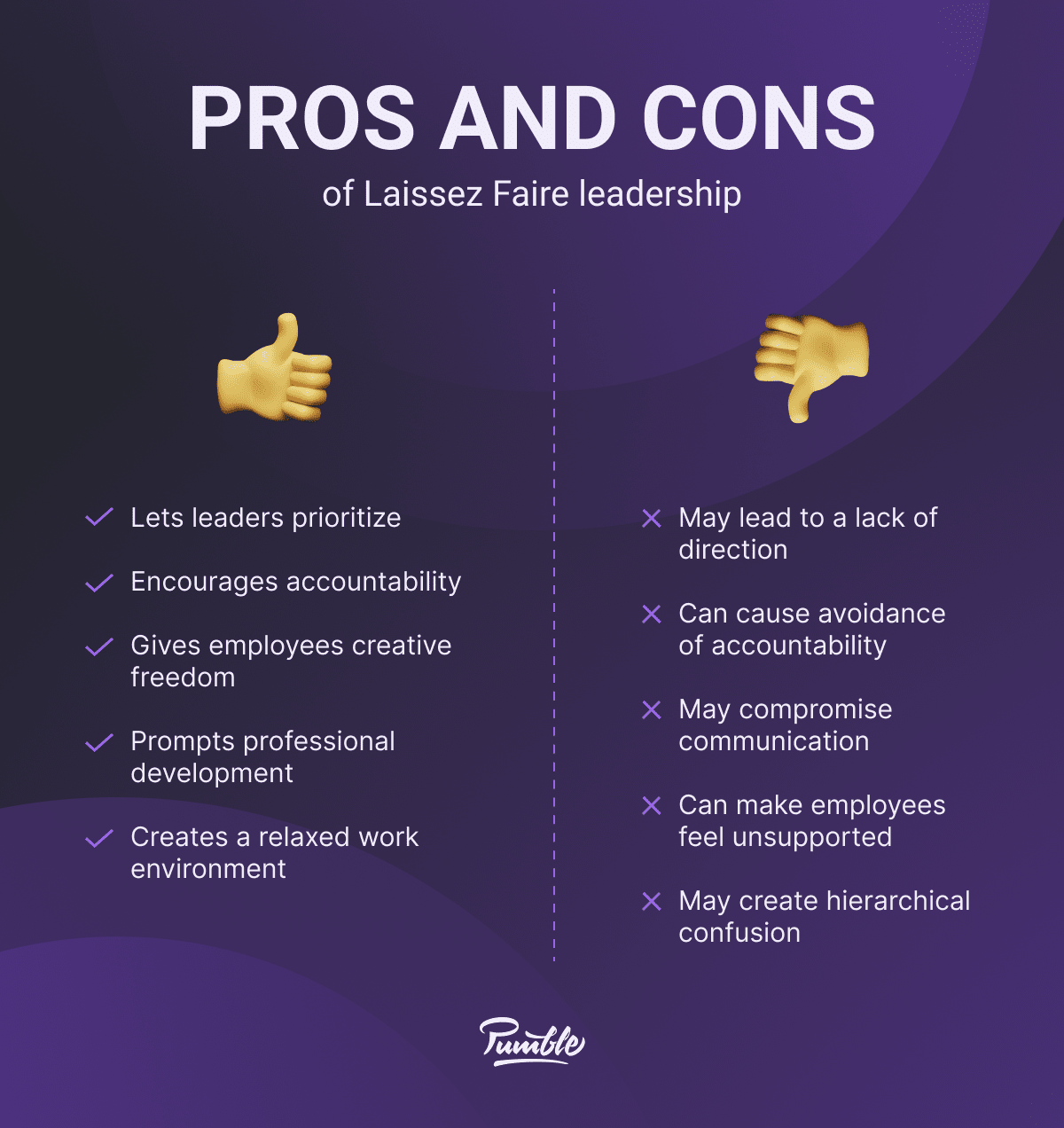
When is laissez-faire leadership appropriate and most effective?
As with any other leadership style, the efficacy of laissez-faire leadership depends on the context it is applied to.
So, when is laissez-faire leadership effective?
Well, in short, there are 3 conditions that justify the use of a laissez-faire leadership style:
- Working in a creative industry,
- Managing experienced and self-motivated employees, and
- Working in a low-stakes environment.
With that being said, let’s talk about these conditions in detail.
Condition #1: Creative jobs
Most experts agree that this style of leadership is well-suited to people working in creative industries such as:
- Entertainment (film and television),
- Technology (software development),
- Design (fashion, animation, or graphic design), or
- Advertising or digital marketing.
However, even though some jobs within these industries require creativity, some of them are still too fast-paced to allow for such a laid-back style of management.
That’s why this condition shouldn’t be used to justify the use of laissez-faire leadership if it’s not accompanied by the other two.
Condition #2: Experienced and self-motivated employees
Arguably, the most important condition for taking a laissez-faire approach to leadership is working with a team of experienced employees.
If everyone on your team knows what their tasks are and how to perform them — there’s no need to meddle in their work.
Like Diane Rosen told us — as long as your employees have demonstrated the ability to work independently, you can feel free to take a more passive role:

“When employees are highly qualified and have demonstrated the ability to work independently, it is appropriate to let them do their jobs without a helicopter boss. Employees who have a strong work ethic, are comfortable with being responsible for their assignments, and will ask for help when they need it will flourish with autonomy.”
On top of that, Paul Bramson noted that trying to apply laissez-faire leadership to a situation that doesn’t meet this requirement can have negative consequences:

“[You shouldn’t use the laissez-faire leadership style] when you have an inexperienced or unmotivated team. If the team lacks experience or motivation, they may struggle with the freedom offered by laissez-faire. In such cases, they might require more guidance and structure to perform effectively. This is especially true with younger and/or inexperienced team members.”
Additionally, Bramson warns against using this approach in high-risk projects (or industries).
Condition #3: Low-risk environments
Since the laissez-faire approach to leadership can easily lead to a lack of accountability, it’s best to avoid it in high-stakes situations.
That’s a piece of advice we received from Constance Dierickx, as well as some of the other experts we have spoken to.
For one, Paul Bramson told us that high-stakes projects tend to require a more involved approach to leadership:

“Projects that involve high stakes or potential risks may require a more involved leadership approach. A hands-off approach can lead to crucial mistakes and misjudgments if not carefully managed.”
Diane Rosen echoed that statement while noting that delegation is still possible even in more stressful work environments as long as you’re working with highly skilled employees:

“A laissez-faire style should be avoided in situations where errors could be high stakes such as endangering the health or safety of others. This does not mean never delegate. It means providing supervision until the leader is assured that the employee can perform and handle the work. But here too, communicating to the employee that supervision is in service of performance and not about not trusting anyone to do the job well can go a long way.”
Of course, being a great laissez-faire leader isn’t just about making sure these conditions are met.
You also have to make sure that you’re ready to support your employees if they come to you with their concerns — which is something we’ll go over later on.
For now, let’s take a brief detour to look at how this management style compares to a more traditional approach to leadership — the democratic style of leadership.
Laissez-faire vs. democratic leadership
As we have previously stated, the opposite of laissez-faire leadership is not democratic leadership, but autocratic leadership.
Leaders who take the autocratic approach seek to establish themselves as the ultimate authority on their team, whereas hands-off leaders and democratic leaders are all about letting their employees have a say.
Furthermore, both democratic and laissez-faire leaders have a high level of trust in their employees. As such, they are more willing to provide their teams with a level of creative freedom and flexibility.
Yet, as similar as these 2 leadership styles are, there are also several differences between them, as the table below shows.
| LAISSEZ-FAIRE LEADERS | DEMOCRATIC LEADERS |
|---|---|
| Absent and disengaged | Present and involved |
| Employees work as individuals | Employees work as a team |
| Empowers employees to make their own decisions | Encourages employees to participate in the decision-making process |
| Gives employees creative freedom | Promotes creativity through collaboration |
| Doesn’t encourage communication | Asks for feedback |
Of course, seeing these contrasting traits of laissez-faire leadership and democratic leadership doesn’t tell us much about what they look like in reality.
With that in mind, let’s spend a moment dissecting each of these points.
Difference #1: Absent and disengaged vs. present and involved
The most obvious difference between laissez-faire leaders and democratic leaders is that the second category is more engaged with their team than the first.
While a laissez-faire leader helms the ship in a hands-off manner, a democratic leader would be more likely to ask all their employees to steer it with them.
In other words, a democratic leader would seek out their employees’ input whenever they feel it is needed.
While some employees might appreciate being asked to contribute to their team and company on that level, others may see these attempts at ongoing communication as disruptive.
Now, there’s a descriptor you’re unlikely to use when talking about a laissez-faire leader.
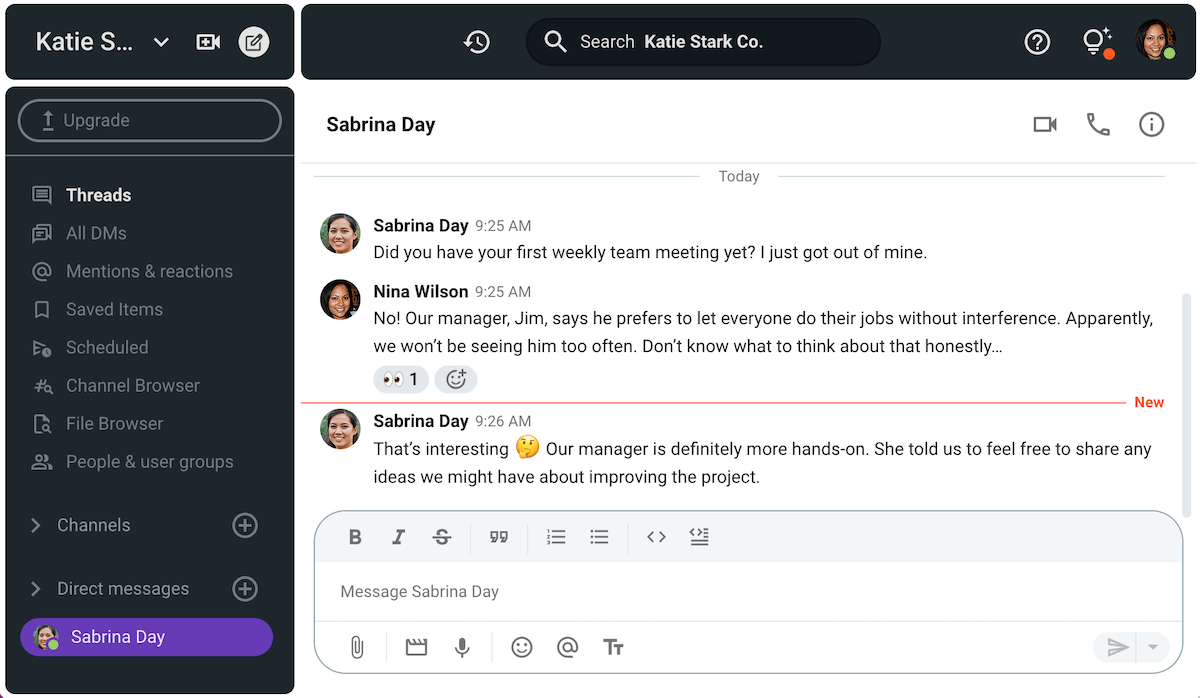
Difference #2: Employees as individuals vs. employees as team members
The second difference we’re going to mention concerns the way employees are perceived by the leaders in the 2 styles of management we are discussing.
Namely, while laissez-faire leaders seem to see their employees as individual workers, democratic leaders tend to see them as group members instead.
Though a democratic leader values every employee for their contributions on an individual level, there is an emphasis on teamwork or collaboration.
This difference will become more apparent as we discuss the next few points.
💡 PUMBLE PRO TIP
Every laissez-faire leader could learn a thing or two about teamwork from the democratic leadership model. If you’re interested in expanding your knowledge of the subject, check out this article:
Difference #3: Employees make their own decisions vs. employees participate in the decision-making process
The next two points we are going to discuss are, in a way, reflections of the previous difference we have spotlighted.
In the spirit of individuality, laissez-faire leaders are known for trusting their employees to make their own decisions about their own work.
Employees can work however they prefer, as long as they finish the tasks within the allotted time.
On the other hand, democratic leaders are also known for sharing the decision-making authority with their employees.
But, once again, the emphasis is on group participation in the decision-making process, not individual decision-making.
In other words, in the democratic leadership model, employees help the leader reach decisions that concern the whole team, not just themselves.
Host productive decision-making sessions in Pumble
Difference #4: Individual creativity vs. creativity through collaboration
Similarly to the previous two points, the individual vs. group thinking of these leadership models can also be seen in their approach to creativity.
As we have learned, the laissez-faire leadership style is great for those working in creative industries.
When you’re working in a creative job, the last thing you want is a boss looking over your shoulder.
Then again, some creative environments require more group collaboration than others.
That is when a more collaborative leadership approach — such as democratic leadership — might be employed instead, to avoid giving any one individual too much sway over the creative process.
💡 PUMBLE PRO TIP
As we have previously mentioned, some work environments are naturally more collaborative than others. To learn about the different types of teams and the way they work together, check out this article:
Difference #5: Low communication vs. open communication
Last but not least, we should mention the different ways laissez-faire leaders and democratic leaders approach group communication.
Though some online resources state that laissez-faire leaders are typically prepared to offer constructive criticism, the simplest form of this leadership style keeps feedback to a minimum.
In fact, the stereotypical laissez-faire leader would be too absent — and presumably, too busy with external affairs — to have much communication with their team members at all.
By contrast, democratic leaders are all about encouraging open team communication and giving feedback.
In their view, more effective communication helps their team collaborate.
Having said all this, it’s important to note that our understanding of the laissez-faire leadership style has changed quite a bit since it was first written about.
In their wish to improve this admittedly lacking leadership model, some leaders have adapted the style by borrowing behaviors from other leadership styles.
Nowadays, anyone looking to be a good laissez-faire leader would also try to improve their communication skills and get comfortable taking charge when their team requires assistance.
So, if you’re interested in practicing this new-and-improved version of laissez-faire leadership, we have some tips for you.
Tips on how to be a better laissez-faire leader
At this point, we all know that laissez-faire leadership has the potential to alienate employees.
If the conditions we have previously mentioned aren’t satisfied, applying this style of leadership to a team could have disastrous consequences for the team and perhaps even the company.
On the other hand, even if the conditions are optimal, you could still have a difficult time practicing the laissez-faire leadership style if you’re unwilling to be flexible.
In short, you have to:
- Work with the right people,
- Learn to let go & delegate effectively,
- Increase employee incentives,
- Offer a flexible work environment,
- Observe performance & provide feedback, and
- Provide assistance & address problems head-on.
But, how do you do that? Let’s find out.
Tip #1: Work with the right people
If you want to practice laissez-faire leadership, the best thing you can do to set yourself up for success is to have a say in who’s on your team.
As we have previously mentioned, the laissez-faire leadership style works best on people who are already experts in their line of work.
That’s why Paul Bramson recommends hiring people who thrive with autonomy:

“Surround yourself with talented, motivated, and capable individuals who can excel with autonomy. Hiring the right people is crucial in a laissez-faire leadership environment.’
Once you have assembled your dream team, you’ll find it much easier to relinquish control and let everyone do what they do best.
Tip #2: Learn to let go & delegate effectively
Some people find it pretty difficult to take a hands-off approach to team management.
But sometimes, letting go is the best thing you can do for your team, as Dr. David Lenihan told us:

“In the short run, one way to flex your laissez-faire leadership chops is to guide yourself away from micromanaging every issue and every detail. Be there as a resource, request final approval, but learn to let things go and allow your team to navigate things independently.”
Once you have given your employees more autonomy, you can try handing over the reins by delegating some tasks as a show of trust, as Diane Rosen suggests:

“Leaders who are comfortable delegating can get a lot back from employees who feel acknowledged, appreciated, and respected.”
Paul Bramson shared this sentiment, adding that delegation is also a great way to increase accountability:

“Trust is a critical component of laissez-faire leadership. Leaders have confidence in their team’s abilities and believe that they will make responsible choices. […]
Encourage your team members to take ownership of their work and projects. Give them the freedom to make decisions and trust their judgment. Empowerment fosters creativity and innovation within the team.”
In other words, delegating is a great way to:
- Show and build trust in your team,
- Learn what everyone on your team is good at,
- Set clear goals and increase accountability, and
- Reduce hierarchical confusion, which can be a big problem for laissez-faire leaders.
Tip #3: Increase employee incentives
So, you have your team of talented, experienced, and competent employees. Now, how do you keep them motivated?
Well, one way to make sure your team stays engaged and motivated is to increase their incentives.
You can do that by simply recognizing the team’s successes publicly, as Paul Bramson suggests:

“Recognize and celebrate the achievements and successes of your team. Positive reinforcement can motivate team members and reinforce the sense of autonomy and responsibility.”
In addition to praise, you can also use monetary rewards like raises, bonuses, or incentives that go beyond those things, such as additional benefits or PTO days.
Either way, rewarding good performance should go a long way toward keeping your team motivated.
Tip #4: Offer a flexible work environment
According to Paul Bramson, one of the biggest benefits of laissez-faire leadership from the employees’ perspective is the incredible flexibility it offers:

“Laissez-faire leaders often promote a flexible work environment, allowing team members to set their schedules and work in ways that suit them best.”
So, use that as a selling point for your approach to leadership.
In the words of Constance Dierickx, providing flexibility will let your employees be aspirational:

“Loosen up so that people can problem-solve, but not just that — allow people to be aspirational. Let go of requirements for them to work certain hours, in particular locations, with a given set of tools, etc.”
Ultimately, if you try to minimize the potential flaws of this approach (by practicing more transparent communication) and highlight its benefits (by providing autonomy and flexibility), you should be able to create the perfect management style for your team.
Tip #5: Observe performance & provide feedback
As a team leader, one of your objectives is to make sure your team is performing to the best of their ability.
But, as you can imagine, laissez-faire leaders tend to take a unique approach to accomplish this task.
Since you don’t want to be looking over your employees’ shoulders, make sure you’re observing their performance from a distance.
Then, you can find opportunities to discuss what you’ve seen either in one-on-one meetings or in group settings.
Scheduling a formal performance review — even in a remote work setting — is going to be easier on your end than on the employees’ end.
Alternatively, if you’re not too keen on the idea of sitting your employees down and telling them what went wrong with the previous project, consider giving them feedforward instead.
In other words, rather than talking about what they might have done differently this time, tell them what they can do differently in the future to promote their professional development.

Use Pumble to effortlessly share constructive feedback
Tip #6: Provide assistance & address problems head-on
Laissez-faire leaders can sometimes have a difficult time establishing themselves as the person their employees should go to for advice and assistance.
So, one of the most important things you can do is make sure your employees feel free to come to you with any problems they have.
Understanding that they can reach out to you at any time will make your team members feel more supported as they go about doing their work.
Luckily, using an employee communication app like Pumble should make this task much more manageable.
For example, being a more visible leader by using public or team-related channels more often will make you appear more approachable to employees.

Remember, communication is the key to establishing a healthy work environment, as Paul Bramson also notes:

“Foster a positive and collaborative work environment. Encourage open communication, mutual respect, and recognition of accomplishments. A positive culture can lead to higher employee engagement and productivity.”
Of course, you don’t have to wait for your employees to bring up a problem.
Make sure you have your finger on the pulse — both in terms of your team’s operations and the company at large.
That will allow you to course-correct if you need to and show that you are a competent leader even if you don’t always have your hands on the steering wheel.
Final thoughts: Even laissez-faire leaders should keep one hand on the steering wheel
Ultimately, the success of the laissez-faire leadership style depends on the needs of your team and organization.
If you’re working with a team of experts who are capable of self-motivating, the best thing you can do is give them the resources, tools, and autonomy they need to do their jobs.
However, you should also try to stay aware of the team’s operations so you can provide feedback, assistance, and direction when necessary.
As Jerome Myers told us, it’s all about adapting the style of leadership to suit your needs:

“Laissez-faire leadership can be a powerful tool when applied in the right context and with the right team. It can unleash creativity, empower employees, and foster a sense of ownership over work. However, leaders must be cautious about the potential pitfalls of this approach, such as the lack of direction and reduced accountability. Like any leadership style, the key to success lies in finding the right balance and adapting the approach to suit the team’s capabilities and the organization’s needs.”







